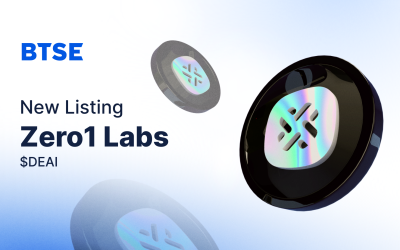The Balancer (BAL) token governs the Balancer Protocol, whose major draw among others is its index funds — serving as liquidity pools for traders, LPs and other participants looking for passive earning streams. BTSE welcomed BAL onto its platform in July.
Balancer is a decentralized finance (DeFi) protocol that launched on the Ethereum blockchain in March 2020. The project was created by Balancer Labs, which raised $3 million in a seed funding round to finance the development of what’s known as a “trustless” protocol for programmable liquidity.
Balancer’s governance token, BAL, is traded on most major exchanges and enables holders to govern the protocol in a decentralized manner, helping guide the project to its full potential. BAL also serves to drive community participation and alignment within the Balancer ecosystem.
BAL has a total supply of 100 million tokens that are periodically distributed to stakeholders, the Balancer Ecosystem Fund, and the Fundraising Fund meant to support Balancer Labs’ operations and development plans.
Read on to learn how the Balancer works and why it stands out from rival DeFi protocols like Uniswap. We will also examine the project’s fundamentals and recent developments.
How Does Balancer Work?
Balancer offers a distributed network that facilitates automatic market making, enabling users to buy or sell various crypto assets without intermediaries.
Liquidity providers (LPs) on the platform can deploy 100% of their own tokens to the Balancer pool and earn a portion of the trading fees paid out to the network. These rewards are distributed weekly in the form of BAL tokens.
The LP deposits ensure that Balancer always has enough liquidity to facilitate traders to seamlessly buy and sell cryptocurrencies in a decentralized manner via the diverse Balancer pools. The protocol deploys a smart order routing system that guarantees quick price execution at low fees.
Balancer algorithms are designed to incentivize both LPs and traders looking for the best crypto prices. In this way, Balancer works similarly to other DeFi protocols that support automatic market-making, such as Curve and Uniswap (CRV and UNI are both traded on BTSE).
However, Balancer is unique in that it offers additional features, most notably, allowing users the ability to bundle up to eight tokens per market. This functionality gives Balancer an edge over other AMMs, for example, that support fewer assets per LP. Another feature that helps Balancer stand out from competitors is the ability for a pool creator to set custom trading fees.
Balancer’s Auto-balancing Index Fund
Balancer Labs made great strides in designing and simulating a revolutionary mathematical framework that allows any pool to constantly self-rebalance while generating fees for the LPs.
Each Balancer pool’s value is based on the percentages of the various cryptocurrencies that make up the pool. A weight for each supported asset within the pool is arbitrarily chosen by the pool creator. The price of tokens in all pools is determined by their deviation from the predetermined weight.
Balancer’s custom smart contracts guarantee that each liquidity pool will retain the precise ratio of tokens even when the prices of individual assets in the pools fluctuate. The protocol also ensures that each asset maintains its value percentage close to the weight, even when market prices of the tokens fluctuate.
In fact, it paves the way for any crypto user to build their own auto-balancing index fund for portfolio management or join an existing one. LPs on Balancer still earn fees on their index funds even when the pool is rebalanced. This is contrary to the traditional index funds model, which requires commodities investors to foot the bill for portfolio management and rebalancing services.
Balancer offers three distinct pools — Shared, Private and Smart pools — to cater to the risk appetites of different users. The Shared pools have fixed parameters that cannot be changed and facilitate any user to deposit their crypto assets and earn fees from the most liquid and popular indexed pools.
Private pools allow only the pool creator to contribute or withdraw liquidity. The creator can also adjust the pool’s parameters, including token weightings, fees, and the types of supported tokens.
Finally, Balancer offers Smart pools that are an iteration of Private pools. These pools are run by smart contracts, allowing operators to program added functions into them, like an index fund that tracks property portfolios.
A Look at Balancer Protocol Fundamentals
Perhaps the most important aspect drawing in users is the Balancer protocol’s indexed funds that serve as liquidity pools for anyone interested in crypto investment and leverage trading. Traders, liquidity providers, and other market participants can all benefit from the service.
As more investors looking for lucrative passive earning streams on their crypto assets join the platform, the Balancer liquidity pools are poised to grow exponentially, making them some of DeFi’s most popular and liquid trading venues.
Balancer is backed by a core team of experienced engineers and mathematicians committed to advancing the project further. Moreover, the protocol is open source and was fully audited by smart contract auditor Trail of Bits before its mainnet launch to bolster user trust.
The Balancer protocol made waves in July by becoming the first DeFi automated market maker (AMM) to integrate three types of pools on its second iteration, Balancer v2. The milestone development improved value and lowered fees for traders, and meant that Balancer’s users could choose among weighted pools, Element pools and the new stable pools. (Element is an open-source protocol for fixed and variable yield markets.)
The decentralized liquidity protocol reached another major milestone recently by expanding beyond Ethereum with its launch on Polygon (MATIC). The move brings novel liquidity solutions to Balancer and Polygon and promises to advance scalability and reduce fees on both networks.
According to Balancer Labs CEO Fernando Martinelli, the protocol is set to benefit from Polygon’s unique combination of high speed and high transaction throughput. Moving aggregating liquidity across pools will also be cheaper due to Polygon’s near-zero fees, making AMM-powered trading on Balancer more cost-efficient for users.
These strong fundamentals point to likely added momentum for the Balancer project. The BAL token trades at $25.27 (August 12), according to CoinGecko.
Emerging Opportunities
Balancer Protocol is transforming DeFi by allowing users to earn fees for contributing aggregated liquidity instead of having them pay portfolio managers for rebalancing their portfolio, as is the case with conventional index funds.
The project provides automated portfolio management that allows DeFi users to profit from emerging arbitrage opportunities.
Balancer is run by an experienced team committed to making the open-source protocol the primary source of liquidity in DeFi, with the aim of providing a powerful and flexible platform for crypto trading and asset management.
Our aim is to create a platform that offers users the most enjoyable trading experience. If you have any feedback, please reach out to us at feedback@btse.com or on Twitter @BTSE_Official.
Note: BTSE Blog contents are intended solely to provide varying insights and perspectives. Unless otherwise noted, they do not represent the views of BTSE and should in no way be treated as investment advice. Markets are volatile, and trading brings rewards and risks. Trade with caution.






